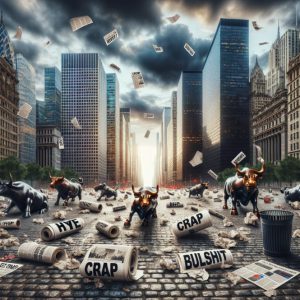
Forever Quantitative Easing, Robbing The Poor to Feed the Rich
Updated Dec 30, 2023
In the intricate world of corporate finance, **share buyback programs** have evolved into a standard tool for earnings manipulation. By decreasing the number of outstanding shares, corporations can artificially inflate their Earnings Per Share (EPS). This strategy once used sparingly, has become widespread, often transforming modest gains or even losses into seemingly impressive profits. It feels as though we’re navigating a maze of deception where the truth struggles to surface.
Analysts predict that US companies’ share buybacks and dividend payments will reach new heights in the upcoming year. Somewhat unsettlingly, the trend suggests that corporations opt for a shortcut to inflate profits rather than invest in sustainable growth. They are directing substantial funds into buying back their shares, bypassing opportunities to invest in innovation or human capital.
In this context, with the **Federal Reserve** pausing its rate hikes, we might see a revival of the Quantitative Easing (QE) program. This program, which essentially involves the central bank purchasing government securities to lower interest rates and increase the money supply, has its share of critics and supporters. If the Fed considers this move, it could significantly reshape the economic landscape. The implications of such a decision could be far-reaching, affecting everyone from top-tier corporations to the average citizen. Understanding these dynamics becomes increasingly crucial in this complex web of corporate strategies and monetary policies.
However, it’s important to note that while share buybacks can boost a company’s EPS and provide a return to investors, they can also signal potential issues with management if used as a primary method of improving financial ratios. Furthermore, while buybacks can increase shareholder value in the short term, they may also indicate that a company is not investing in future growth, which could ultimately cost shareholders in the long run.
Moreover, the substantial amount of buybacks conducted in recent years has raised questions about corporate resilience, especially in light of the economic toll of the Covid-19 pandemic. This has led to concerns about whether these buybacks have increased the need for public support.
In conclusion, while share buybacks can be a valuable tool for corporations, they should not be used as a substitute for sustainable growth and investment. As we navigate this intricate labyrinth of corporate finance, it’s crucial to keep an eye on these dynamics and understand their potential implications.
Share Buybacks: An Unyielding Trend
In 2021, corporations directed an impressive $881.7 billion towards share buybacks, marking a significant increase from previous years. This trend continued to surge in 2022, setting a new annual record at $922.7 billion for the S&P 500 companies. It’s a phenomenon that analysts, investors, and economic observers are watching closely.
Why this seemingly relentless drive towards what some might view as fiscal recklessness? The answer lies in the interconnected dynamics of corporate incentives and economic conditions. With low-interest rates making borrowing cheap and executive compensation often tied to share performance, the motivation to create an illusion of robust financial health is vital. The availability of ‘easy money’ only adds fuel to this fire, enabling businesses to continue this trend for as long as the conditions allow.
2023, a new dynamic was introduced – a 1% excise tax on net buybacks. This new regulation could potentially impact the rate of share buybacks. However, considering the historical trend and the fact that this tax is relatively small, it’s plausible that the trend of share buybacks could continue its upward trajectory in 2023.
In this intricate dance of corporate strategy and economic policy, one thing is clear – share buybacks have become an addiction of sorts for corporations. This trend appears to be unstoppable for the time being.
The Buyback Boom: A Closer Look at Corporate Alchemy
In recent years, the trend of corporations repurchasing their shares has not only persisted but reached new heights. In 2021, companies in the S&P 500 invested a substantial $881.7 billion in share buybacks. This figure was eclipsed in 2022, with an annual record of $922.7 billion spent on buybacks, underscoring the unwavering appeal of this strategy among large corporations.
**Why do companies continue to buy back shares at such a pace?** The reasons are multifaceted. Low borrowing costs and aligning executive compensation with share performance create compelling incentives for companies to pursue buybacks. By reducing the number of outstanding shares, companies can boost earnings per share (EPS), thereby creating a favourable impression of financial health and efficiency without necessarily improving underlying business performance.
The trend has been so robust that in the fourth quarter of 2022 alone, S&P 500 companies executed $211.2 billion in share repurchases. This slight increase from the third quarter of the same year contributed to the record-setting annual total. Despite a new 1% excise tax on net buybacks introduced in 2023, which on a proforma basis would have slightly reduced operating earnings by 0.51% in 2022, the momentum of share buybacks has not shown signs of a significant slowdown.
The buyback phenomenon is not limited to the United States. Globally, share buybacks surged to a record $1.31 trillion in 2022, nearly matching the dividends paid out in the same period. This represents a staggering 182% increase in buybacks since 2012, far outpacing the 54% dividend increase. The oil sector, in particular, contributed significantly to this growth, with North American, UK, and European companies leading the charge.
**The implications of this trend are profound.** While buybacks can benefit shareholders in the short term by increasing share value, they raise questions about the long-term sustainability of such practices. Critics argue that the funds used for buybacks could instead be invested in wages, research and development, or other areas that could contribute to the real economy and long-term corporate growth.
As we look to the future, it remains to be seen how the interplay between economic policy, corporate strategy, and market conditions will shape the trajectory of share buybacks. What is clear, however, is that share repurchases have become a profoundly entrenched component of corporate financial strategy, reflecting a significant shift in how companies manage their capital and reward their shareholders.
Share Buybacks: A Parallel to Quantitative Easing
Share buybacks have become prevalent among corporations, particularly in the S&P 500, where a record $922.7 billion was spent on repurchases in 2022. This trend, which has consistently risen over the years, can draw parallels to the concept of Quantitative Easing (QE) employed by central banks.
QE is a monetary policy wherein a central bank purchases government or other securities from the market to increase the money supply and encourage lending and investment. When central banks implement QE, they create money out of thin air to purchase these assets, aiming to stimulate economic activity.
Similarly, corporations engage in their form of QE through share buybacks. By repurchasing their own shares, companies use capital to reduce the number of shares outstanding, which can artificially inflate earnings per share and, consequently, the stock price. This can create an illusion of prosperity and improved financial performance without actual growth in revenue or profits.
Often, these buybacks are not funded by excess cash reserves but through debt. Corporations use low-interest rates to borrow money, which they use to repurchase shares. This practice can be likened to the borrowing mechanism of QE, where money is created or borrowed against future growth expectations.
The Illusion of Prosperity: Just as QE can lead to concerns about the long-term health of an economy by potentially creating asset bubbles and increasing debt levels, share buybacks can mask underlying issues within a company. They can divert funds away from productive investments in innovation, infrastructure, or workforce development, which could generate sustainable growth and value.
The Debt Factor: The increasing corporate debt to fund buybacks is a concern, as it adds to the company’s liabilities. If the expected increase in share value does not materialize or if the company faces a downturn, the debt remains, potentially exacerbating financial strain.
The Economic Impact: While QE aims to stimulate the economy by increasing the money supply and encouraging investment, share buybacks concentrate wealth among existing shareholders, often leading to criticism that they do little to benefit the broader economy. The funds used for buybacks could potentially be invested in ways that would create jobs, raise wages, or drive innovation.
In conclusion, share buybacks share similarities with QE regarding their goals and mechanisms. Still, they also raise important questions about the long-term implications for the companies involved and the economy. The debate continues on whether this trend represents a wise capital allocation or a short-term strategy prioritizes perceived financial health over actual economic contribution.
Les embarks on a journey through history, we delve into the saga of Forever Quantitative Easing, tracing its narrative from as far back as 2015. In this exploration, we unravel valuable lessons, emphasizing that those who overlook history risk reliving its echoes.
The Buyback Boom: A Closer Look at Corporate Alchemy
Last year, corporations allocated $540-$700 billion towards share buybacks. In April 2015 alone, a record-breaking $141 billion was authorized for buybacks, marking a 121% increase from the same month in the previous year. This trend shows no signs of slowing down. If the current pace continues, corporations could allocate approximately $1.2 trillion for share buybacks in 2015, shattering the 2007 record of $863 billion.
Over the past decade, companies that make up the S&P 500 have spent over 54% of profits on share buybacks. Since 2001, businesses in the S&P 500 alone have spent over $3.1 trillion on buybacks. These figures are not just staggering; they represent a significant shift in corporate strategy.
In the past, a substantial portion of earnings would be reinvested into the economy through higher wages and increased investments in plants and equipment. However, the current trend of share buybacks drains trillions of dollars out of the economy, inflating share prices while producing nothing of tangible value.
Under constant pressure to increase EPS, corporate executives have found a new way to meet this demand. Instead of improving earnings through traditional means, such as selling more products or services, they can increase the EPS by reducing the number of outstanding shares. This modern form of alchemy transforms the corporate landscape, but at what cost?
With the Federal Reserve halting its rate hikes, there’s a looming possibility that we might see a resumption of the Quantitative Easing (QE) program. If this happens, it could further fuel the buyback boom, potentially exacerbating the wealth gap and creating an even more precarious economic situation. As we navigate this complex landscape, it’s crucial to understand these dynamics and their potential implications.
Goldman Sachs forecasts that an 18% jump in buybacks for 2015.
“Corporate activity in early 2015 supports our view that the S&P 500 will return more than $1 trillion of cash to investors this year,” said David Kostin, chief U.S. equity strategist at Goldman in New York in an April 24 note to clients. Full Story
Goldman Sachs projects an 18% surge in buybacks for 2015, amplifying concerns about the growing influence of corporate repurchases. The Federal Reserve’s balance sheet has ballooned to around $2.4 trillion since the advent of quantitative easing (QE). Intriguingly, S&P 500 companies have outpaced even the Fed, expending a whopping $2.41 trillion on share buybacks during this bullish market phase. This raises a critical question: Have US corporations stepped into the shoes left vacant by the Fed?
A potentially alarming revelation surfaced in the first quarter, where S&P 500 companies disbursed more money to shareholders than they earned. This echoes a disturbing trend in the fourth quarter of 2008 when the entire S&P 500 reported a net loss yet allocated $110 billion to dividends and share buybacks. The echo of history prompts scrutiny, and according to Howard Silverblatt, a senior index analyst at S&P Dow Jones Indices, there seems to be a resonance that warrants attention.
As the financial landscape undergoes a transformation where corporate actions overshadow earnings, the intersection of market dynamics and monetary policy becomes increasingly intricate. The implications of this trend extend far beyond balance sheets, subtly shaping the future trajectory of markets and posing critical questions about sustainability.
James Montier’s Bold Stand Against the Obsession with ‘Shareholder Value Maximization’
In a paper titled “The World’s Dumbest Idea,”. He goes on to illustrate how this obsession with stock buybacks and dividends has reduced business investment; Montier states that shareholders are not providing capital to corporations but are instead extracting it. He shows that since 1980, public companies have repurchased more equity than they have issued.
How did we get to this stage? Before regulations were loosened in 1982 by John Shad, corporate executives avoided share buybacks because they were afraid of being prosecuted. The change in rules and the shift towards stock-based compensation for executives changed the financial landscape forever. This article does a pretty good job for those of you looking for more details.
Market Dynamics Unveiled: The Endemic Rise of Stock Buybacks
Stock buybacks, once an occasional financial tool, have evolved into an endemic practice within the corporate landscape. More than 25% of S&P 500 companies utilize this strategy, indicating its widespread adoption. Experts are concerned about this pervasive trend’s impact on market dynamics.
The strategy is so deeply ingrained that even industry titans like Apple are not immune to its allure. The mechanism is simple—by repurchasing their shares, companies inflate earnings per share (EPS) and, consequently, drive up share prices. This creates a self-perpetuating cycle, as higher share prices incentivize more companies to engage in similar practices.
Why invest time and effort in substantial business improvements when, with easy access to borrowed funds, a company can create the illusion of a thriving business? This rhetorical question underlines the predicament faced by many corporations today.
Delving into the realm of executive compensation, the landscape becomes even more complex. In 2012, the 500 highest-paid executives in U.S. public companies averaged an astonishing $30.3 million each. A substantial 42% of their compensation was derived from stock options, while 41% came from stock awards. This financial incentive structure aligns executives’ interests with the success of stock buybacks.
However, beneath the temporary boost in share prices lies the potential masking of declining profitability. As companies focus on meeting quarterly EPS targets, the business’s long-term health may be compromised. The ramifications of this widespread phenomenon extend beyond individual corporations, casting shadows on the integrity of the broader market dynamics. In examining this complex landscape, the timeless adage rings true: those who do not learn from history are doomed to repeat it.
Conclusion: The Mirage of Prosperity in the Age of Forever QE and Share Buybacks
The corporate world has become adept at painting a veneer of prosperity, a mirage that shimmers with the allure of ever-rising stock prices and the facade of robust financial health. The mechanism fueling this illusion is a blend of endless Quantitative Easing (QE) and aggressive share buybacks—a potent concoction with significant economic and societal implications.
At the heart of this phenomenon lies the era of cheap money—interest rates that have hovered at historical lows, enabling corporations to borrow vast sums with relative ease. This access to inexpensive capital has not only facilitated the repurchase of shares to record-breaking figures, such as the $922.7 billion spent by S&P 500 companies in 2022, but has also encouraged the accumulation of corporate debt.
The incentivization structure in corporate America further exacerbates this situation. When executive compensation is intricately tied to stock performance, the motivation to pursue strategies that inflate share prices—often without genuine value creation—is overpowering. The stakes are high, and the allure of immediate gratification overshadows the sobering long-term consequences of such actions.
For the average Joe, this environment remains largely inaccessible. The cheap money that corporate entities leverage is beyond the reach of everyday individuals—until, inevitably, a pathway emerges that entices the masses to take on debt. It is reminiscent of the prelude to the housing bubble, where the average person was lured into unsustainable financial commitments, ultimately left holding the bag when the bubble burst.
While the Federal Reserve may have officially halted its QE program, corporations have stealthily assumed the role of liquidity providers. Using borrowed funds or even their reserves to buy back shares perpetuates the cycle of artificial prosperity. This shadow QE continues unabated, propping up share prices in a manner disconnected from the underlying economic growth, which remains lacklustre at best.
This dissonance is stark: stock prices have doubled over the past five years, marching in lockstep with a parallel surge in corporate indebtedness. It’s a correlation too pronounced to dismiss as mere coincidence. Instead, it’s a testament to the engineered nature of this growth—a growth fertilized by the easy money policies of central banks and meticulously pruned by corporate executives through share buybacks.
In this landscape, we witness not the triumph of free-market dynamics but the birth of a distorted economic reality. Forever, QE, in its corporate guise, has not only sustained but also inflated asset prices, creating an illusion of prosperity that is both intoxicating and treacherous.
Standing at the precipice of this financial chimaera, we must recognize the sleight of hand before us. The actual economy—the one that exists beyond stock tickers and earnings calls—needs genuine investment and innovation. Until our focus shifts from the brief to the substantive, the illusion of prosperity will persist, as will the risk of its inevitable dissolution.
I doubt if a single individual could be found from the whole of mankind free from some form of insanity. The only difference is one of degree. A man who sees a gourd and takes it for his wife is called insane because this happens to very few people.
Desiderius Erasmus
Engaging Articles That Bridge Different Fields

Dividend Capture ETF: The Lazy Investor’s Dividend Strategy

What Was the Panic of 1907: A Triumph of Folly Over Reason

What Time is the Best Time to Invest in Stocks? When Fools Panic

The Volatility Paradox: Calm Markets but Soaring ‘Fear Gauge’ Trading

Which of the Following is a Characteristic of Dollar-Cost Averaging

Synthetic Long: Unlock Extreme Leverage Without the Risk
Best Ways to Beat Inflation: Resist the Crowd, Gain Insight

Gambler’s Fallacy Psychology: The Path to Losing

Dividend Harvesting: A Novel Way to Turbocharge Returns

Capital Market Experts: Loud Mouths, No Action

Modern Investing: Innovative Approaches in the Stock Market

Adaptive Markets Hypothesis: Master It to Win Big in Investing

Stock Market Crash Michael Burry: Hype, Crap, and Bullshit

Mainstream Media: Your Path to Misinformation and Misfortune

Market Dynamics Unveiled: Stock Market Is a Lagging Indicator

Mass Media Manipulates: Balancing Awareness & Trend Adoption

What Are Two Ways Investors Can Make Money from Stocks: A Holistic Approach
What is a Paradox: Understanding the Laws of Life and the Path to Peace


